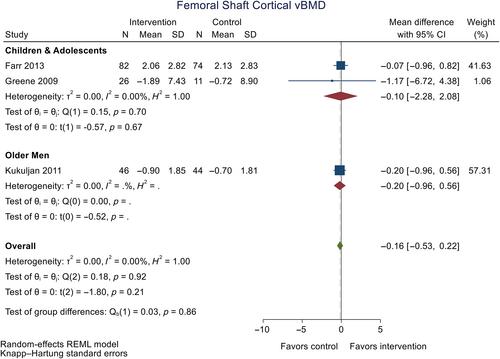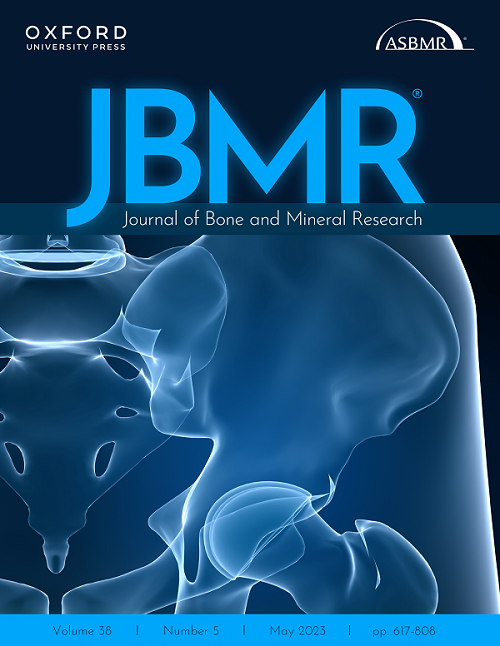下载PDF
{"title":"中高强度运动训练对骨骼结构的影响:随机对照试验的系统回顾和荟萃分析。","authors":"Carrie-Anne Ng, Anoohya Gandham, Jakub Mesinovic, Patrick J Owen, Peter R Ebeling, David Scott","doi":"10.1002/jbmr.4899","DOIUrl":null,"url":null,"abstract":"<p>Moderate- to high-impact exercise improves bone mineral density (BMD) across the lifespan, but its effects on bone structure, which predicts fracture independent of areal BMD, are unclear. This systematic review and meta-analysis investigated effects of impact exercise on volumetric BMD (vBMD) and bone structure. Four databases (PubMed, Embase, SPORTDiscus, Web of Science) were searched up to March 2022 for randomized controlled trials (RCTs) investigating the effects of impact exercise, with ground reaction forces equal to or greater than running, compared with sham or habitual activity, on bone vBMD and structure. Bone variables were measured by quantitative computed tomography or magnetic resonance imaging at the tibia, radius, lumbar spine, and femur. Percentage changes in bone variables were compared among groups using mean differences (MD) and 95% confidence intervals (CI) calculated via random effects meta-analyses. Subgroup analyses were performed in children/adolescents (<18 years), adults (18–50 years), postmenopausal women, and older men. Twenty-eight RCTs (<i>n =</i> 2985) were included. Across all studies, impact exercise improved trabecular vBMD at the distal tibia (MD = 0.54% [95% CI 0.17, 0.90%]), total vBMD at the proximal femur (3.11% [1.07, 5.14%]), and cortical thickness at the mid/proximal radius (1.78% [0.21, 3.36%]). There was no effect on vBMD and bone structure at the distal radius, femoral shaft, or lumbar spine across all studies or in any subgroup. In adults, impact exercise decreased mid/proximal tibia cortical vBMD (−0.20% [−0.24, −0.15%]). In postmenopausal women, impact exercise improved distal tibia trabecular vBMD (0.79% [0.32, 1.25%]). There was no effect on bone parameters in children/adolescents in overall analyses, and there were insufficient studies in older men to perform meta-analyses. Impact exercise may have beneficial effects on bone structure and vBMD at various skeletal sites, but additional high-quality RCTs in different age and sex subgroups are needed to identify optimal exercise protocols for improving bone health across the lifespan. © 2023 The Authors. <i>Journal of Bone and Mineral Research</i> published by Wiley Periodicals LLC on behalf of American Society for Bone and Mineral Research (ASBMR).</p>","PeriodicalId":185,"journal":{"name":"Journal of Bone and Mineral Research","volume":"38 11","pages":"1612-1634"},"PeriodicalIF":5.1000,"publicationDate":"2023-08-09","publicationTypes":"Journal Article","fieldsOfStudy":null,"isOpenAccess":false,"openAccessPdf":"https://asbmr.onlinelibrary.wiley.com/doi/epdf/10.1002/jbmr.4899","citationCount":"0","resultStr":"{\"title\":\"Effects of Moderate- to High-Impact Exercise Training on Bone Structure Across the Lifespan: A Systematic Review and Meta-Analysis of Randomized Controlled Trials\",\"authors\":\"Carrie-Anne Ng, Anoohya Gandham, Jakub Mesinovic, Patrick J Owen, Peter R Ebeling, David Scott\",\"doi\":\"10.1002/jbmr.4899\",\"DOIUrl\":null,\"url\":null,\"abstract\":\"<p>Moderate- to high-impact exercise improves bone mineral density (BMD) across the lifespan, but its effects on bone structure, which predicts fracture independent of areal BMD, are unclear. This systematic review and meta-analysis investigated effects of impact exercise on volumetric BMD (vBMD) and bone structure. Four databases (PubMed, Embase, SPORTDiscus, Web of Science) were searched up to March 2022 for randomized controlled trials (RCTs) investigating the effects of impact exercise, with ground reaction forces equal to or greater than running, compared with sham or habitual activity, on bone vBMD and structure. Bone variables were measured by quantitative computed tomography or magnetic resonance imaging at the tibia, radius, lumbar spine, and femur. Percentage changes in bone variables were compared among groups using mean differences (MD) and 95% confidence intervals (CI) calculated via random effects meta-analyses. Subgroup analyses were performed in children/adolescents (<18 years), adults (18–50 years), postmenopausal women, and older men. Twenty-eight RCTs (<i>n =</i> 2985) were included. Across all studies, impact exercise improved trabecular vBMD at the distal tibia (MD = 0.54% [95% CI 0.17, 0.90%]), total vBMD at the proximal femur (3.11% [1.07, 5.14%]), and cortical thickness at the mid/proximal radius (1.78% [0.21, 3.36%]). There was no effect on vBMD and bone structure at the distal radius, femoral shaft, or lumbar spine across all studies or in any subgroup. In adults, impact exercise decreased mid/proximal tibia cortical vBMD (−0.20% [−0.24, −0.15%]). In postmenopausal women, impact exercise improved distal tibia trabecular vBMD (0.79% [0.32, 1.25%]). There was no effect on bone parameters in children/adolescents in overall analyses, and there were insufficient studies in older men to perform meta-analyses. Impact exercise may have beneficial effects on bone structure and vBMD at various skeletal sites, but additional high-quality RCTs in different age and sex subgroups are needed to identify optimal exercise protocols for improving bone health across the lifespan. © 2023 The Authors. <i>Journal of Bone and Mineral Research</i> published by Wiley Periodicals LLC on behalf of American Society for Bone and Mineral Research (ASBMR).</p>\",\"PeriodicalId\":185,\"journal\":{\"name\":\"Journal of Bone and Mineral Research\",\"volume\":\"38 11\",\"pages\":\"1612-1634\"},\"PeriodicalIF\":5.1000,\"publicationDate\":\"2023-08-09\",\"publicationTypes\":\"Journal Article\",\"fieldsOfStudy\":null,\"isOpenAccess\":false,\"openAccessPdf\":\"https://asbmr.onlinelibrary.wiley.com/doi/epdf/10.1002/jbmr.4899\",\"citationCount\":\"0\",\"resultStr\":null,\"platform\":\"Semanticscholar\",\"paperid\":null,\"PeriodicalName\":\"Journal of Bone and Mineral Research\",\"FirstCategoryId\":\"3\",\"ListUrlMain\":\"https://onlinelibrary.wiley.com/doi/10.1002/jbmr.4899\",\"RegionNum\":1,\"RegionCategory\":\"医学\",\"ArticlePicture\":[],\"TitleCN\":null,\"AbstractTextCN\":null,\"PMCID\":null,\"EPubDate\":\"\",\"PubModel\":\"\",\"JCR\":\"Q1\",\"JCRName\":\"ENDOCRINOLOGY & METABOLISM\",\"Score\":null,\"Total\":0}","platform":"Semanticscholar","paperid":null,"PeriodicalName":"Journal of Bone and Mineral Research","FirstCategoryId":"3","ListUrlMain":"https://onlinelibrary.wiley.com/doi/10.1002/jbmr.4899","RegionNum":1,"RegionCategory":"医学","ArticlePicture":[],"TitleCN":null,"AbstractTextCN":null,"PMCID":null,"EPubDate":"","PubModel":"","JCR":"Q1","JCRName":"ENDOCRINOLOGY & METABOLISM","Score":null,"Total":0}
引用次数: 0
引用
批量引用



